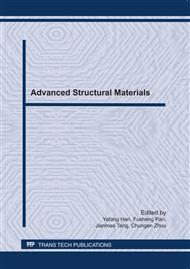p.740
p.745
p.752
p.758
p.765
p.770
p.778
p.784
p.792
Preparation of Polyacrylonitrile High Modulus Carbon Fibers by Catalytic Graphitization Using Boron
Abstract:
Catalytic graphitization of polyacrylonitrile-based carbon fiber by doping boric acid was reported in this paper. The microstructure and mechanical properties of polyacrylonitrile-based carbon fibers with and without doping boric acid after heat treatment of 1300°C,1500°C,1800°C, 2100°C,2300°C,2400°Cand 2500°Cwas investigated by X-ray diffraction (XRD) and mechanical testing. The results showed that the tensile modulus of the carbon fibers either boron modified or not, increased obviously with increasing temperatures, and that of the modified carbon fibers was much higher than the unmodified fibers at all temperatures, reaching 404Gpa when the fiber was graphitized at 2500°C. The tensile strength of the modified carbon fibers was lower than the unmodified ones after being graphitized at temperatures below 2300°C, but increased to 2.69 GPa and 2.46 GPa respectively after the fibers were treated at 2300°C and 2500°C, which were higher than that of unmodified fibers treated under the same conditions, indicatinging that the mechanism of boron catalytic graphitization changed at the temperatures higher than 2300°C. It also showed that the interlayer spacing (d002) decreased, while the crystallite size (Lc) and the orientation increased with increasing temperatures.
Info:
Periodical:
Pages:
778-783
Citation:
Online since:
June 2011
Authors:
Price:
Сopyright:
© 2011 Trans Tech Publications Ltd. All Rights Reserved
Share:
Citation:


